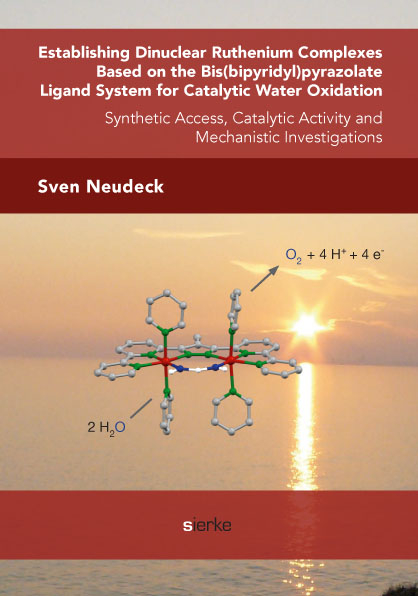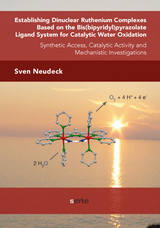Establishing Dinuclear Ruthenium Complexes Based on the Bis(bipyridyl)pyrazolate Ligand System for Catalytic Water Oxidation:
Synthetic Access, Catalytic Activity and Mechanistic Investigations
Seiten
2016
sierke VERLAG - Sierke WWS GmbH
978-3-86844-851-1 (ISBN)
sierke VERLAG - Sierke WWS GmbH
978-3-86844-851-1 (ISBN)
The implementation of an energy supply based on renewable sources
is one of the future‘s great challenges. The production of solar
fuels by artificial photosynthesis is considered as a potential solution
to this problem. In this context, water oxidation, i.e. the oxidation
of water into molecular dioxygen, was identified as bottleneck.
This work contributes to meet this challenge by establishing a new
family of dinuclear ruthenium complexes as catalysts for water
oxidation. These complexes are based on the rigid bis(bipyridyl)
pyrazolate ligand system and were prepared via a synthetic key
intermediate. Members of this family proved to be efficient catalysts
for water oxidation. The influence of different substitutents on
both the electrochemistry and catalytic activity was systematically
investigated.
The synthesis of a highly water soluble complex allowed detailed
mechanistic investigations. They include the characterisation of different
oxidation states by a bundle of spectroscopic methods and
the construction of a Pourbaix diagram. Labelling experiments revealed
that the oxygen-oxygen bond formation – the key step of
the water oxidation process – takes place via a water nucleophilic
attack. Finally, a mechanistic scenario for the water oxidation process
for this family of dinuclear complexes was developed. Thereby,
complexes based on the bis(bipyridyl)pyrazolate ligand system
found their way into the illustrious circle of in-depth analysed water
oxidation catalysts.
is one of the future‘s great challenges. The production of solar
fuels by artificial photosynthesis is considered as a potential solution
to this problem. In this context, water oxidation, i.e. the oxidation
of water into molecular dioxygen, was identified as bottleneck.
This work contributes to meet this challenge by establishing a new
family of dinuclear ruthenium complexes as catalysts for water
oxidation. These complexes are based on the rigid bis(bipyridyl)
pyrazolate ligand system and were prepared via a synthetic key
intermediate. Members of this family proved to be efficient catalysts
for water oxidation. The influence of different substitutents on
both the electrochemistry and catalytic activity was systematically
investigated.
The synthesis of a highly water soluble complex allowed detailed
mechanistic investigations. They include the characterisation of different
oxidation states by a bundle of spectroscopic methods and
the construction of a Pourbaix diagram. Labelling experiments revealed
that the oxygen-oxygen bond formation – the key step of
the water oxidation process – takes place via a water nucleophilic
attack. Finally, a mechanistic scenario for the water oxidation process
for this family of dinuclear complexes was developed. Thereby,
complexes based on the bis(bipyridyl)pyrazolate ligand system
found their way into the illustrious circle of in-depth analysed water
oxidation catalysts.
| Erscheinungsdatum | 12.09.2016 |
|---|---|
| Verlagsort | Göttingen |
| Sprache | englisch |
| Maße | 148 x 210 mm |
| Gewicht | 750 g |
| Einbandart | geklebt |
| Themenwelt | Naturwissenschaften ► Chemie ► Anorganische Chemie |
| Naturwissenschaften ► Chemie ► Physikalische Chemie | |
| Schlagworte | Artificial Photosynthesis • Coordination Chemistry • Electrochemistry • Homogeneous catalysis • Inorganic Chemistry • Mechanistic Studies • Oxygen-Oxygen Bond Formation • Ruthenium Complexes • spectroscopy • Water oxidation |
| ISBN-10 | 3-86844-851-9 / 3868448519 |
| ISBN-13 | 978-3-86844-851-1 / 9783868448511 |
| Zustand | Neuware |
| Haben Sie eine Frage zum Produkt? |
Mehr entdecken
aus dem Bereich
aus dem Bereich




